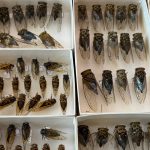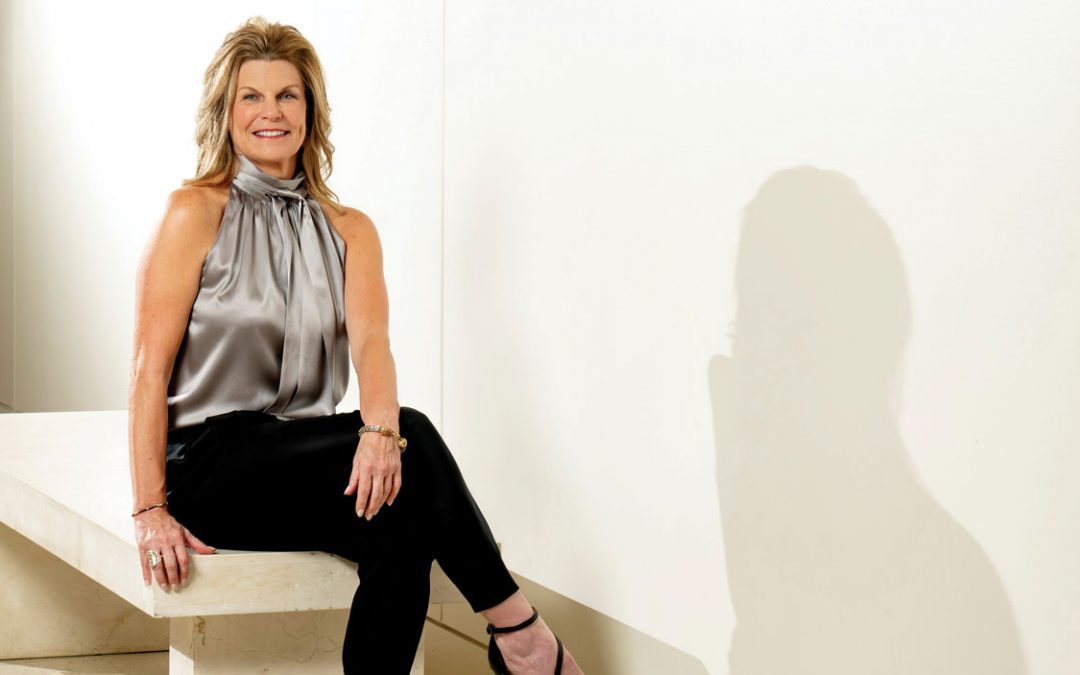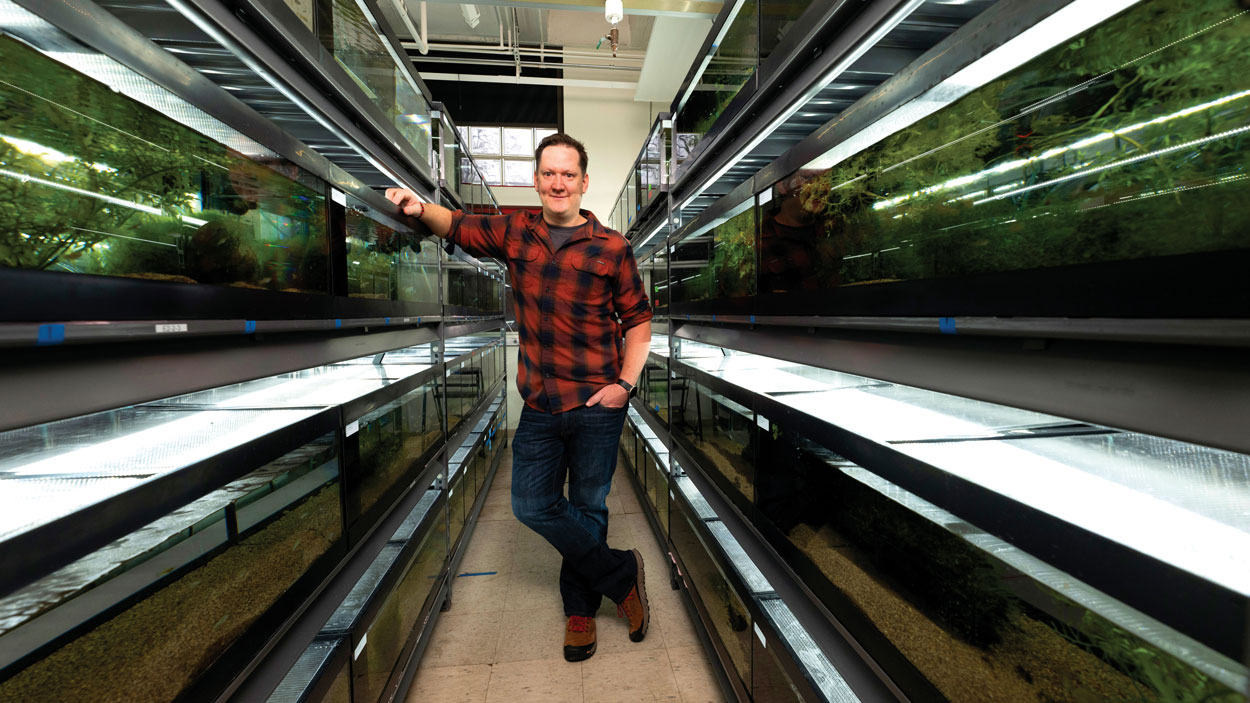
Michi Tobler, the E. Desmond Lee Endowed Professor in Zoological Studies, stands amid one of the rows of fish tanks in his lab on the first floor of the Research Building at the University of Missouri–St. Louis. (Photo by Derik Holtmann)
Snow was starting to accumulate outside one Friday morning in February at the University of Missouri–St. Louis, but it still felt almost tropical where Michi Tobler stood, surrounded by rows of fish tanks stacked more than 7 feet high, in Room 101 of the Research Building.
The residents of those tanks – a collection of species gathered from Mexico and parts of Central America – are accustomed to temperatures of more than 80 degrees.
Tobler wants to keep them happy and thriving, so he sets the thermostat accordingly.
There are hundreds of them, most not much longer than an AA battery and iridescent, with hues of green, yellow and red shimmering on the top and sides of their slender bodies. Tobler brought them with him from Kansas State University last fall when he assumed his position as the E. Desmond Lee Endowed Professor in Zoological Studies in UMSL’s Department of Biology, and they hold the key to his research.
“We study fish that occur in environments where other fish, or sometimes other animals, don’t really manage to exist,” Tobler says. “We call those extreme environments. There’s some combination of environmental factors that make it almost impossible to hang out. We’ve been using those fish and essentially treating them as a natural experiment. Some of them made it, and they’re thriving in places where nothing or almost nothing else can, so we can ask all sorts of questions about what allows them to push the limits.”
He’s found plenty of funders interested in exploring those questions – and discovering their answers – as well, having received more than $6.8 million in grants from agencies such as the National Science Foundation, the U.S. Department of Defense and the Army Research Office throughout his career.
•••
Tobler’s interest in fish living in extreme environments was first sparked when he attended a scientific talk by biologist Martin Plath in his native Switzerland. At the time, Tobler was pursuing his master’s degree at the Swiss Federal Institute of Technology Zürich, and he went to Plath’s presentation on fish that live in dark environments.

A front chamber of Cueva del Azufre in Tabasco,
Mexico, has baby-blue water due to the sulfur compounds derived from hydrogen sulfide. Professor Michi Tobler studies fish that live in those extreme conditions. (Photo by Robbie Shone)
“It was an amazing talk,” Tobler says. “He was talking about these cave fish in Mexico that live in complete darkness. Within 10,000 generations, they had evolved their ability to essentially do things in the darkness that their surface ancestors couldn’t do. He just blew it out of the water.”
Tobler was eager to speak with Plath afterward.
“If you ever go to Mexico and you need a guy that just helps you,” Tobler remembers telling him, “I’m your guy.”
Plath wound up calling him about six months later to let him know he’d gotten funding to do field work in Mexico. Tobler joined him there for three weeks, working 16-hour days gathering data on the fish – a type of livebearer from the family Poeciliidae with the scientific name Poecilia mexicana – and their environment.
“I was totally hooked,” he says.
It turned out the cave where the fish lived was not only dark. The water also contained hydrogen sulfide, a toxicant lethal to most living things except the fish and a handful of other creatures.
Tobler was intrigued and wanted to understand how they survived.
For a while, he explored that question on the side, even as he began doctoral research on unisexual fish while working with his mentor Ingo Schlupp, whom he’d followed from Switzerland to the University of Oklahoma. But eventually, with Schlupp’s blessing, Tobler decided to change course.
“I remember I was so nervous talking to him,” Tobler says. “I was like, ‘Look, I’m not going to write my dissertation about what I’ve been doing the last one and a half or two years. I’m going to write my dissertation about this.’ That’s kind of how it all got started.”
•••
Tobler has come to understand how common it is to find organisms thriving in unusual living conditions.
“When you start looking, they’re everywhere,” Tobler says. “There are extreme environments in Missouri. It’s the cave state. There’s lots of weird cave critters here.”
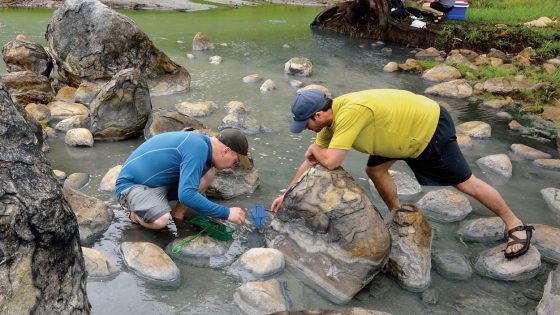
Michi Tobler and a colleague collect fish at La Gloria, a sulphur spring in Tabasco, Mexico. (Photo by Robbie Shone)
His lab studies a number of fish living under harsh circumstances. One of his doctoral students is interested in looking for patterns in genetic adaptations that occur among different species of cave fish. He also has a master’s student who researches a livebearer fish called the Pecos Gambusia mosquitofish living in high-salinity desert springs in New Mexico as part of a project funded by the U.S. Fish and Wildlife Service.
But Tobler has maintained a particular focus on livebearer fish that have adapted to live in the presence of hydrogen sulfide.
“They’re really great models because they’re super abundant and you can easily keep them in the lab,” he says.
The fish have colonized caves in one particular place in southern Mexico but can be found far more frequently in hydrogen-sulfide-rich surface springs throughout the Americas.
Such pungent-smelling waters are plentiful near Villahermosa in Mexico as well as in Costa Rica, the Dominican Republic and even Florida. The fish that call them home can often be found living less than 100 meters from fresh streams populated with other mollies that appear to be from the same species. There are no obvious characteristic differences except that they can survive where their neighbors cannot.
“They’re just so tough,” Bethany Williams says admiringly.
Williams joined Tobler’s lab as an NSF-funded postdoctoral fellow in August after earning her PhD in biology at The Ohio State University. She is interested in understanding how multiple stressors impact different organisms in tandem, and she’s found extreme environments – particularly these hydrogen-sulfide-rich springs and the fish that live in them – to be fertile for that type of work.
“I think they can tell us a lot about what traits they have that are allowing them to survive in there,” Williams says.
•••
That’s been the biggest mystery for Tobler to unlock over the course of two decades studying these fish.
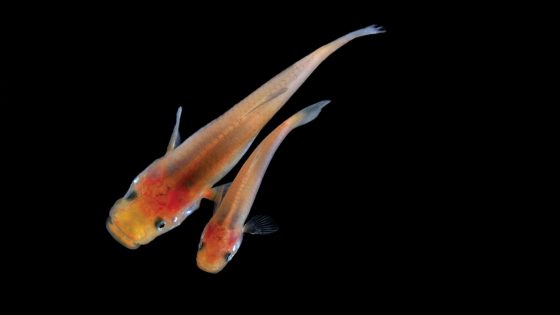
Michi Tobler studies cave mollies (Poecilia mexicana) that have adapted to survive in hydrogen-sulfide-rich water found in springs in Mexico and other part of Central America. (Photo by Robbie Shone)
When he first got started, he says he functioned primarily as an ecologist, measuring water levels and keeping tabs on which species made it and which did not. He collected plenty of data about the behavior of the fish and could fill a lecture with interesting tidbits of information, but he was missing something important.
“Every single talk I gave,” Tobler says, “the first question people asked was, ‘How do they do it? How do they survive?’”
At the time, he didn’t know. But the past decade has provided a lot of insight.
In most organisms, hydrogen sulfide proves toxic because, at a cellular level, it binds to a protein in the mitochondria and shuts down the production of adenosine triphosphate, or ATP, which is the energy currency fueling each cell’s activity.
The fish Tobler studies have adapted to continue producing ATP despite the presence of hydrogen sulfide.
He saw two potential explanations. The first was that they’d modified the protein so that hydrogen sulfide could no longer bind with it, shutting off energy production. The other was that the fish’s cells developed a way to eliminate or detoxify the hydrogen sulfide.
Research has shown that many organisms, including humans, can do the latter, at least on a small scale. It’s likely a legacy tool inherited from each organism’s ancestors that developed during a time when hydrogen sulfide was much more common in the environment.
“These fish have basically upped their pre-existing detoxification pathway,” Tobler says, “so they make a lot more of these proteins that detoxify the sulfide.”
His lab has been able to drill down from the organism level to the organelle, isolating the mitochondria to study how it works, then going down further to learn about the particular proteins involved. They’ve even been able to identify the genes encoding the proteins.
Tobler’s research has led to nearly 130 peer-reviewed publications in journals such as Molecular Ecology and the Journal of Evolutionary Biology.
•••
Tobler was as surprised as anyone when he first learned of the biomedical community’s interest in hydrogen sulfide.
“It is a really peculiar substance,” he says. “There was some work in mice that showed that if given just the right amount of hydrogen sulfide, you can induce suspended animation-like states. You basically can put things down to a physiological state where breathing slows down, the heart rate slows down, the body temperature cools down. Then they were able to basically wake up or revive these mice with no evidence of any sort of cognitive side effects.”
That’s led practitioners connected to the National Institutes of Health and the U.S. military to wonder about potential applications for the substance.
Imagine using hydrogen sulfide at precise levels to slow tissue decay in a donated organ, such as a heart or liver. Could that prolong the window of time to identify a suitable recipient, and could it reduce rejection rates and increase the rate of survival for transplant patients?
Similarly, what if it were possible to administer non-toxic levels of hydrogen sulfide to a soldier who suffers a traumatic injury on a battlefield? Could that increase the window that exists to get the soldier off the field and to a hospital to receive proper treatment?
The fish Tobler studies are helping to provide some answers.
“If you study a mouse, there’s no such thing as a tolerant mouse,” he says. “All you can study is how the system fails eventually. But we have a beautiful natural experiment. We’ve been able to study how a system fails in the presence of sulfide in these nontolerant fish that live in regular streams, and we can see what those adapted fish are doing and start pinpointing it. What’s the difference in the physiology and the genetics between populations that are probably causing these differential responses? I think that is the power of our system.”
As Tobler knows, there is more to learn.
This story was originally published in the spring 2024 issue of UMSL Magazine. If you have a story idea for UMSL Magazine, email magazine@umsl.edu.


